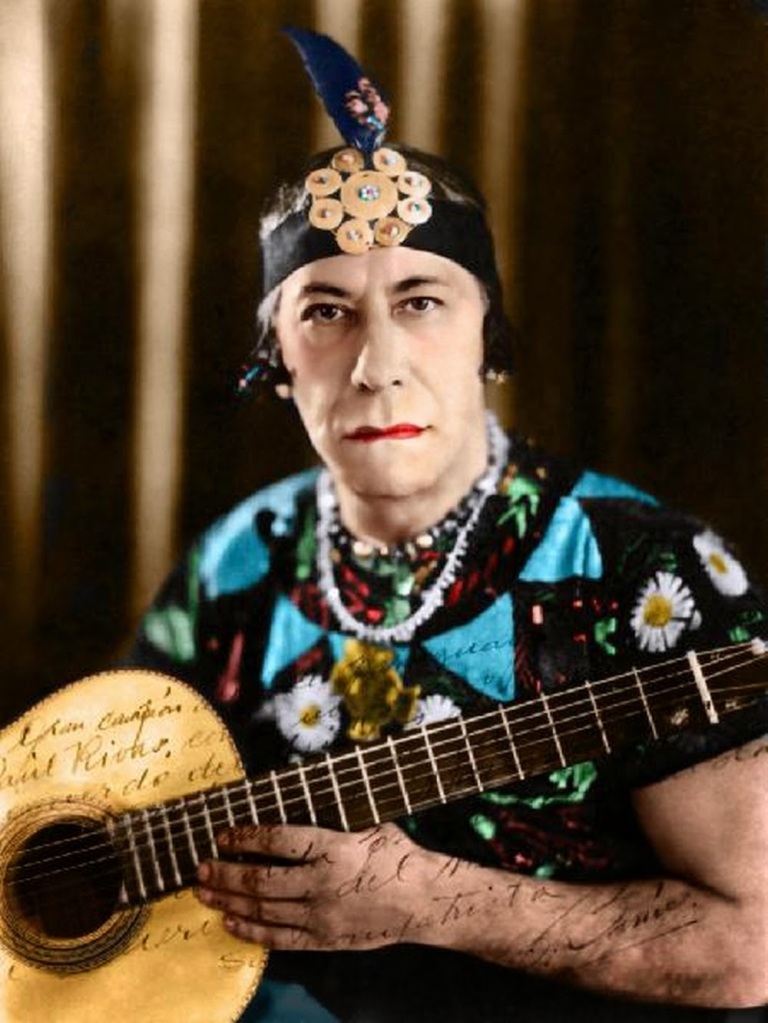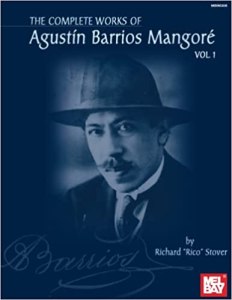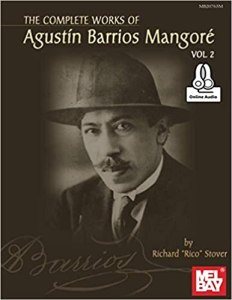Biography
Paraguayan composer Agustín Barrios Mangoré (1885-1944) was one of the most prolific composers for guitar, as well as a virtuoso performer.
Barrios was part of the indigenous Guaraní people, and therefore drew heavily upon Paraguayan folk music influences which he incorporated into his diverse compositional style.
For a period of several years beginning in 1932, Barrios occasionally dressed in traditional Guaraní garments for performances. During this time, he would go by the pseudonym Nitsuga Mangoré (Agustín spelled backwards, and Mangoré being a folkloric chief hero of the Guarani people).
This and other details of Barrios’s life are recounted in Richard Stover’s book Six Silver Moonbeams.

Barrios composed over 300 musical works. From bold luscious chords with swooping melodies, to lightening fast melodic runs with complex rhythmic structures, the music of Barrios has something to offer everyone.
Some scholars like to divide the prolific music of Barrios into three categories: folkloric, imitative, and religious.
Popular Guitar Works by Agustín Barrios
Below are some of my favorite Barrios compositions. These are also some of the most popular Barrios pieces in the classical guitar repertoire.
You can buy volumes 1 and 2 of the complete Barrios guitar works here:
Julia Florida
The beautifully melodic piece Julia Florida is possibly Barrios’s most well-known and commonly played guitar work.
The piece is a Barcarola in drop D tuning, 6/8 time, with three distinct sections. One can feel the ‘boat song’ influence almost immediately with a slow, swaying rhythm, as though one was paddling through waves in deep calm waters.
The first section of the piece opens with broad mellow chords that lead right into the sweet and memorable theme. This theme in D major is juxtaposed beautifully with a new section that starts off in the relative minor key (B minor). Following this brief section, Barrios then modulates to some A minor material before returning to the key of D major.
According to Richard Stover, author of a Barrios biography entitled Six Silver Moonbeams, Barrios wrote Julia Florida in December of 1938 while living in Costa Rica. Barrios was experiencing difficulty due to diminishing health and a lack of regular employment.
Julia Florida was dedicated to Francisco Salazar’s niece, Julia Martinez whom Barrios taught. Allegedly, they called her Julia ‘Florida’ because she grew up very fast in adolescence (“florida” means “bloomed” as in florece–”to bloom or flower”).
You can hear Barrios’s fondness for Julia in every lasting, delicate phrase of this timeless masterpiece:
La Cathedral: Preludio, Andante, Allegro
The three movement suite La Cathedral by Barrios is one of the most epic suites in guitar repertoire.
Overall, the suite has a tragic tone. La Cathedral builds in intensity throughout each movement, and perfectly demonstrates the three categorizations of Barrios mentioned above (folkloric, imitative, and religious).
The slow and delicate opening section entitled Preludio “Saudade”, refers to a deep emotional state of longing or nostalgia. It’s rare for a piece to begin in such a high register of the guitar (high F# on the first string, 14th fret). However, one can hear the vulnerability and sadness immediately with intricate voicings that almost sound like arpeggios, but are actually three distinct parts.
In the second movement, entitled Andante Religioso, Barrios displays his Baroque-inspired compositional influence. The movement is largely chordal, but still offers a clear melodic line. Although the movement is not particularly long, the rich chords and metered 6/8 rhythm portrays a funeral march-like quality.
The final movement, entitled Allegro Solemne (solemn), brings La Catedral to an exciting and dramatic conclusion.
You can watch La Cathedral performed by Ana Vidovic in it’s entirety below:
Un Sueño en la Floresta
I feel that Un Sueño en la Floresta (A Dream in the Forest) contains one of the most beautiful themes in all of Barrios’s compositions. Admittedly, I’m biased having grown up listening to the superb recording of my uncle David Richter’s rendition of the piece on his album bearing the same name (Un Sueño en la Floresta).
This piece is very demanding to the guitarist, as it utilizes the entire fretboard, and requires various right hand techniques such as pizzicato, harmonics, and finely controlled tremolo.
Un Sueño begins with a moderately-paced dreamy opening with lush chords, light harmonics, and a thumping pizzicato phrase.
Next, the main theme opens with an elaborate and bold tremolo section. This is followed by a swooping melodic line, interspersed with light pulsing chords, almost as though dragonflies were swooping by you erratically.
The piece then returns to a tremolo theme and reaches a climactic high B tremolo note on the first string 19th fret (the highest fret on standard classical guitars). Throughout the piece, one can hear an operatic influence. It’s as though the wailing tremolo is like a vocal vibrato echoing in a deep forest.
Enjoy the performance of Un Sueño en la Floresta performed by David Russell below:
Una Limosna por el Amor Dios
Una Limosna por el Amor Dios (An Alm for the Love of God) by Agustín Barrios might be the most popular tremolo piece in guitar repertoire other than Recuredos de la Alhambra by Francisco Tárrega. Unsurprisingly, this piece is also known by its subtitle: El Ultimo Tremolo. Given the title, one can see that this work falls within the ‘religious’ Barrios composition category.
The dramatic and desperate introduction quickly opens to the main tremolo theme of the piece. In contrast to Un Sueño en la Floresta, the tremolo technique in Una Limosna por el Amor Dios continues throughout the piece until the final two chords.
David Russell tells a nice story about how Barrios came up with the name and introduction to this piece. You can hear more of the story and a masterful performance of the piece here:
Las Abejas
The short but lightening fast piece Las Abejas (The Bees) is an example of Barrios’s imitative compositional style. Quick arpeggio and scale passages, wide left hand spreads, and swift right hand consistency are all requirements for playing this piece effectively!
One can hear some similarities between this piece and the Allegro Solemne section of La Cathedral. If you thought the music of Barrios was rather moderate or even slow and dramatic–Las Abejas will make you think again!
Vals Op.8 No.3 (Primavera) & No.4
Barrios’s Opus 8 is a collection of four waltzes (vals) that are some of the most popular in the guitar repertoire. While all four waltzes are gorgeous, Op.8 No.3 and No.4 are performed most often and make my shortlist of top Barrios compositions.
Danza Paraguaya
Danza Paraguaya is one of Barrios’s most challenging and exciting guitar works. This technically demanding piece is generally played at a fast tempo (allegro).
Barrios was so fond of the Danza Paraguaya tune, he also composed a duet version of the piece.
Below is yet another virtuosic performance by David Russell of the solo version of Danza Paraguaya No.1 composed by Barrios:


